
The Great Salt Lake is the largest saltwater lake in the Western Hemisphere and the eighth-largest terminal lake in the world. It lies in the northern part of the U.S. state of Utah and has a substantial impact upon the local climate, particularly through lake-effect snow. It is a remnant of Lake Bonneville, a prehistoric body of water that covered much of western Utah.

Tooele County is a county in the U.S. state of Utah. As of the 2010 United States Census, the population was 58,218. Its county seat and largest city is Tooele. The county was created in 1850 and organized the following year.

Stansbury Park is a census-designated place (CDP) in Tooele County, Utah, United States. As of the 2020 United States Census, the population was 9,851, up from the 2010 figure of 5,145.
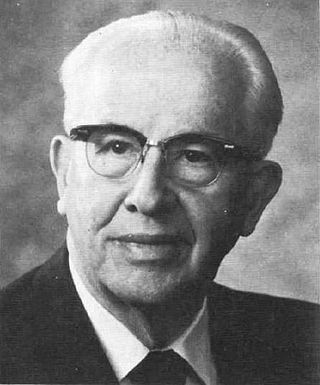
Ezra Taft Benson was an American farmer, government official, and religious leader who served as the 15th United States Secretary of Agriculture during both presidential terms of Dwight D. Eisenhower and as the 13th president of the Church of Jesus Christ of Latter-day Saints from 1985 until his death in 1994.

The Mormon Trail is the 1,300-mile (2,100 km) long route from Illinois to Utah that members of the Church of Jesus Christ of Latter-day Saints traveled from 1846-47. Today, the Mormon Trail is a part of the United States National Trails System, known as the Mormon Pioneer National Historic Trail.
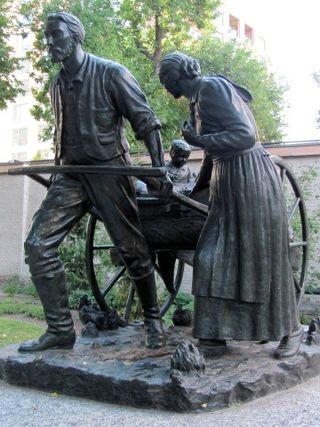
The Mormon pioneers were members of the Church of Jesus Christ of Latter-day Saints, also known as Latter Day Saints, who migrated beginning in the mid-1840s until the late-1860s across the United States from the Midwest to the Salt Lake Valley in what is today the U.S. state of Utah. At the time of the planning of the exodus in 1846, the territory was part of the Republic of Mexico, with which the U.S. soon went to war over a border dispute left unresolved after the annexation of Texas. The Salt Lake Valley became American territory as a result of this war.

Ezra Taft Benson was an apostle and a member of the Quorum of the Twelve Apostles of the Church of Jesus Christ of Latter-day Saints.
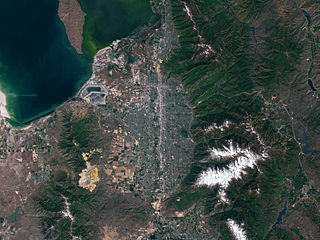
Salt Lake Valley is a 500-square-mile (1,300 km2) valley in Salt Lake County in the north-central portion of the U.S. state of Utah. It contains Salt Lake City and many of its suburbs, notably Murray, Sandy, South Jordan, West Jordan, and West Valley City; its total population is 1,029,655 as of 2010. Brigham Young said, "this is the right place," when he and his fellow Mormon settlers moved into Utah after being driven out of several states.

The Hastings Cutoff was an alternative route for westward emigrants to travel to California, as proposed by Lansford Hastings in The Emigrant's Guide to Oregon and California. The ill-fated Donner Party infamously took the route in 1846.

The History of Utah is an examination of the human history and social activity within the state of Utah located in the western United States.

The This is the Place Monument is a historical monument at the This is the Place Heritage Park, located on the east side of Salt Lake City, Utah, at the mouth of Emigration Canyon. It is named in honor of Brigham Young's famous statement in 1847 that the Latter-day Saint pioneers should settle in the Salt Lake Valley. Mahonri M. Young, a grandson of Brigham Young, sculpted the monument between 1939 and 1947 at Weir Farm in Connecticut. Young was awarded $50,000 to build the monument in 1939 and he was assisted by Spero Anargyros. It stands as a monument to the Mormon pioneers as well as the explorers and settlers of the American West. It was dedicated by LDS Church President George Albert Smith on 24 July 1947, the hundredth anniversary of the pioneers entering the Salt Lake Valley. It replaced a much smaller monument located nearby.
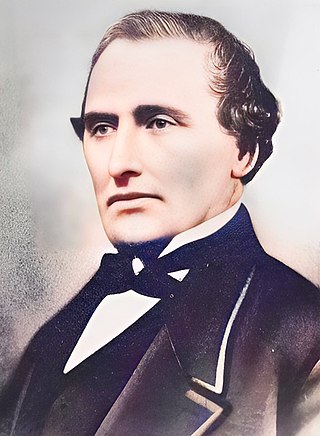
Peter Maughan was an early pioneer of the Church of Jesus Christ of Latter-Day Saints who settled the Cache Valley of Utah under the direction of Brigham Young.
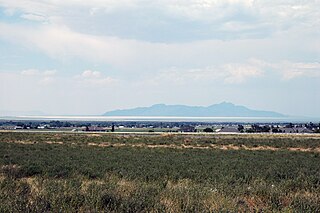
Stansbury Island is the second largest island within the Great Salt Lake in the U.S. state of Utah. Located in Tooele County, it is considered an island even though a dirt causeway connects it to the mainland. Stansbury Island was named after Howard Stansbury, the leader of a government expedition that surveyed the lake in 1849.
The Overland Trail was a stagecoach and wagon trail in the American West during the 19th century. While portions of the route had been used by explorers and trappers since the 1820s, the Overland Trail was most heavily used in the 1860s as a route alternative to the Oregon, California, and Mormon trails through central Wyoming. The Overland Trail was famously used by the Overland Stage Company owned by Ben Holladay to run mail and passengers to Salt Lake City, Utah, via stagecoaches in the early 1860s. Starting from Atchison, Kansas, the trail descended into Colorado before looping back up to southern Wyoming and rejoining the Oregon Trail at Fort Bridger. The stage line operated until 1869 when the completion of the First transcontinental railroad eliminated the need for mail service via stagecoach.
Howard Stansbury was a major in the U.S. Army Corps of Topographical Engineers. His most notable achievement was leading a two-year expedition (1849–1851) to survey the Great Salt Lake and its surroundings. The expedition report entitled Exploration and survey of the valley of the Great Salt Lake of Utah, including a reconnaissance of a new route through the Rocky Mountains was published in 1852 providing the first serious scientific exploration of the flora and fauna of the Great Salt Lake Valley as well as a favorable impression of the members of the Church of Jesus Christ of Latter-day Saints, who had settled there beginning in 1847.

Benson Grist Mill is a restoration-replica museum located in Tooele County, Utah in the western United States, which allows visitors to see the inner workings of a latter-nineteenth-century pioneer gristmill. It has four other historic (nineteenth-century) buildings which have been moved onto the site, as well as four ancillary structures, including an open-air pavilion. It covers 6.98 acres along State Highway 138, 0.8 mile southwest of the intersection of the Road with State Highway 36. The museum is owned and operated by a division of Tooele County.

Settlement of the Church of Jesus Christ of Latter-day Saints, also called Mormons, Latter-day Saints, or Saints in the Salt Lake Valley and surrounding area or “the planning and founding of more than 500 communities in the American West, is regarded by many planning historians as one of the most significant accomplishments in the history of American city development”. The Saints moved from settlement to settlement, until they made a permanent home in the Great Basin of the Rocky Mountains. This group of people is characterized by their ability to work together in settlement efforts. In 1847, these people trekked en masse across the great plains of the United States until they reached what is now northern Utah. Led by Brigham Young, these people used their experience of settling to establish themselves there. The church provided critical leadership by organizing and directing the efforts of the people. While Salt Lake City, the headquarters of the LDS Church, is their most prominent achievement, many other settlements in the area were also very successful. The techniques of the farm village, plats, and the grid, were all important components for the initial establishment, and later development, of the uninhabited area. The presence of the Saints in the valley was useful in the concluding efforts of the Transcontinental Railroad, where Promontory, Utah served as the connecting point of the Union Pacific and Central Pacific lines. Often labeled “the Crossroads of the West,” this area became an important hub for people traveling west, particularly for the California Gold Rush. While initially an agrarian community, the Saints became a strong force for industry as mines, factories, and rail began to be completely utilized.
Mormon Road, also known to the 49ers as the Southern Route, of the California Trail in the Western United States, was a seasonal wagon road pioneered by a Mormon party from Salt Lake City, Utah led by Jefferson Hunt, that followed the route of Spanish explorers and the Old Spanish Trail across southwestern Utah, northwestern Arizona, southern Nevada and the Mojave Desert of California to Los Angeles in 1847. From 1855, it became a military and commercial wagon route between California and Utah, called the Los Angeles – Salt Lake Road. In later decades this route was variously called the "Old Mormon Road", the "Old Southern Road", or the "Immigrant Road" in California. In Utah, Arizona and Nevada it was known as the "California Road".
The Battle at Fort Utah was a battle between the Timpanogos Tribe and remnants of the Nauvoo Legion at Fort Utah in modern-day Provo, Utah. The Timpanogos people initially tolerated the presence of the settlers, and the two groups enjoyed some moments of mutual friendship. However, after three Mormons murdered a Timpanogos man called Old Bishop for stealing, the Timpanogos then took around 50 Mormon cattle, settlers in Fort Utah petitioned to go to war with the Timpanogos. Isaac Higbee, Parley P. Pratt and Willard Richards convinced Brigham Young to exterminate any Timpanogos hostile to the Mormon settlement. Young sent the Nauvoo Legion down with Captain George D. Grant and later sent General Daniel H. Wells to lead the army. After the Timpanogos defended themselves from their village and an abandoned cabin, they fled their camp. The Mormons pursued the Timpanogos from Chief Old Elk's tribe and any other Timpanogos they found in the valley, killing Timpanogos from Chief Pareyarts or Para-yah 's tribe. The Nauvoo Legion killed some Timpanogos.

Adobe Rock is described by the USGS as a pediment (geology) at Lake Point, Utah. The large rock outcropping sits adjacent to SR-36 just north of SR-138 at Mills Junction. Because of its distance from the steep incline of the Oquirrh Mountains and its prominent location on the edge of a hill, Adobe Rock has served as a natural landmark in Tooele Valley ever since the first pioneers traversed the Hastings Cutoff trail. Though not officially a national monument like its nearby peer Black Rock, it has equal significance as a navigating landmark and cultural significance as a monument with businesses using the Adobe Rock name, books using its images on their covers, and Lake Point, Utah depicting its likeness as their city logo.


























